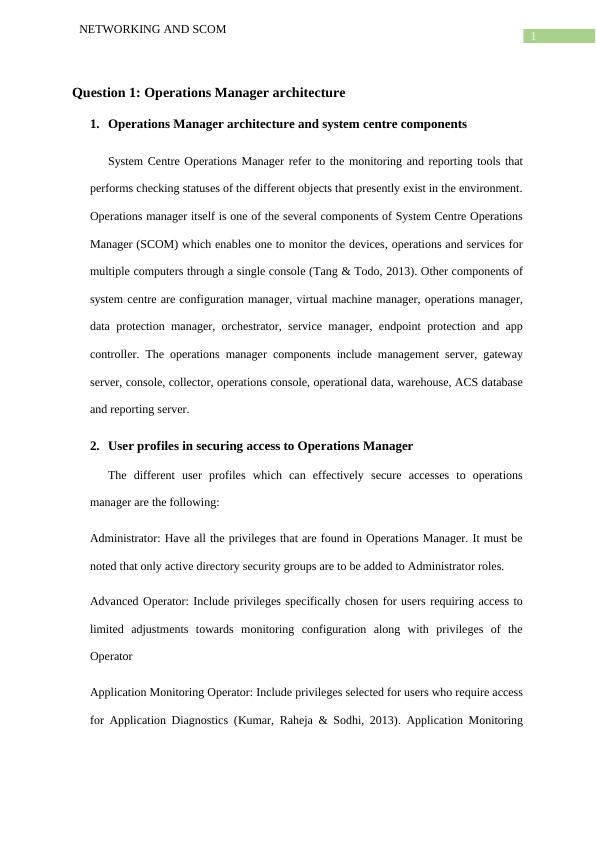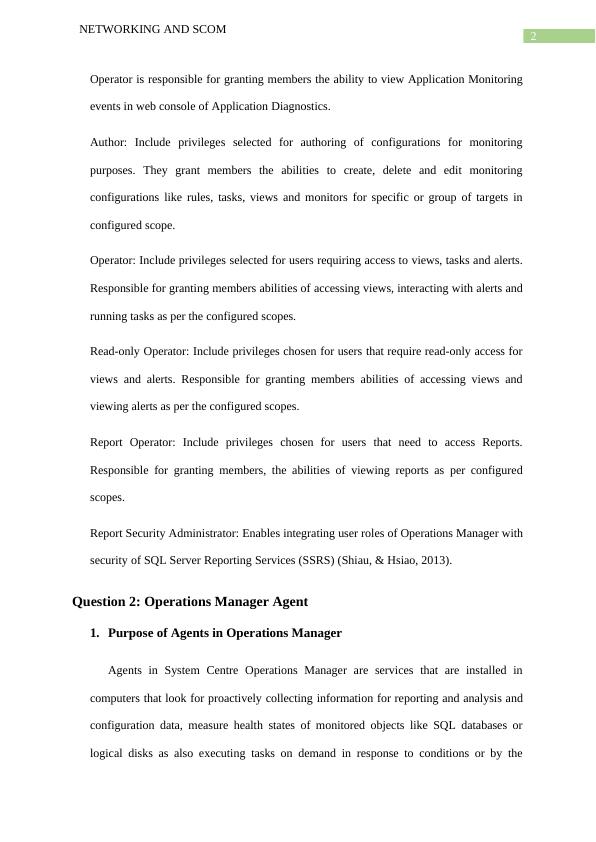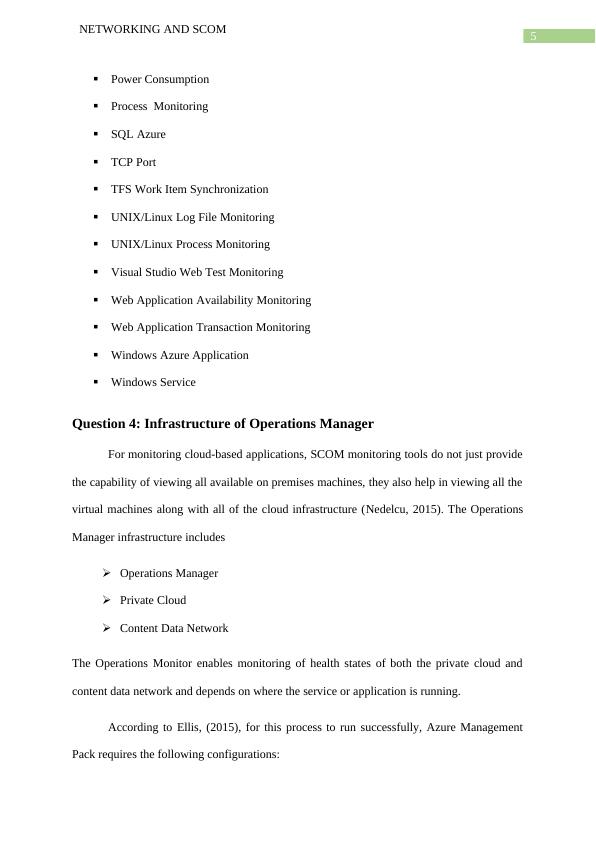NETWORKING AND SCOM Networking and Operations Manager SCOM Name
Added on 2023-04-07
26 Pages3845 Words192 Views
Running head: NETWORKING AND SCOM
Networking and Operations Manager SCOM
Name of the Student
Name of the University
Author Note
Networking and Operations Manager SCOM
Name of the Student
Name of the University
Author Note

1
NETWORKING AND SCOM
Question 1: Operations Manager architecture
1. Operations Manager architecture and system centre components
System Centre Operations Manager refer to the monitoring and reporting tools that
performs checking statuses of the different objects that presently exist in the environment.
Operations manager itself is one of the several components of System Centre Operations
Manager (SCOM) which enables one to monitor the devices, operations and services for
multiple computers through a single console (Tang & Todo, 2013). Other components of
system centre are configuration manager, virtual machine manager, operations manager,
data protection manager, orchestrator, service manager, endpoint protection and app
controller. The operations manager components include management server, gateway
server, console, collector, operations console, operational data, warehouse, ACS database
and reporting server.
2. User profiles in securing access to Operations Manager
The different user profiles which can effectively secure accesses to operations
manager are the following:
Administrator: Have all the privileges that are found in Operations Manager. It must be
noted that only active directory security groups are to be added to Administrator roles.
Advanced Operator: Include privileges specifically chosen for users requiring access to
limited adjustments towards monitoring configuration along with privileges of the
Operator
Application Monitoring Operator: Include privileges selected for users who require access
for Application Diagnostics (Kumar, Raheja & Sodhi, 2013). Application Monitoring
NETWORKING AND SCOM
Question 1: Operations Manager architecture
1. Operations Manager architecture and system centre components
System Centre Operations Manager refer to the monitoring and reporting tools that
performs checking statuses of the different objects that presently exist in the environment.
Operations manager itself is one of the several components of System Centre Operations
Manager (SCOM) which enables one to monitor the devices, operations and services for
multiple computers through a single console (Tang & Todo, 2013). Other components of
system centre are configuration manager, virtual machine manager, operations manager,
data protection manager, orchestrator, service manager, endpoint protection and app
controller. The operations manager components include management server, gateway
server, console, collector, operations console, operational data, warehouse, ACS database
and reporting server.
2. User profiles in securing access to Operations Manager
The different user profiles which can effectively secure accesses to operations
manager are the following:
Administrator: Have all the privileges that are found in Operations Manager. It must be
noted that only active directory security groups are to be added to Administrator roles.
Advanced Operator: Include privileges specifically chosen for users requiring access to
limited adjustments towards monitoring configuration along with privileges of the
Operator
Application Monitoring Operator: Include privileges selected for users who require access
for Application Diagnostics (Kumar, Raheja & Sodhi, 2013). Application Monitoring

2
NETWORKING AND SCOM
Operator is responsible for granting members the ability to view Application Monitoring
events in web console of Application Diagnostics.
Author: Include privileges selected for authoring of configurations for monitoring
purposes. They grant members the abilities to create, delete and edit monitoring
configurations like rules, tasks, views and monitors for specific or group of targets in
configured scope.
Operator: Include privileges selected for users requiring access to views, tasks and alerts.
Responsible for granting members abilities of accessing views, interacting with alerts and
running tasks as per the configured scopes.
Read-only Operator: Include privileges chosen for users that require read-only access for
views and alerts. Responsible for granting members abilities of accessing views and
viewing alerts as per the configured scopes.
Report Operator: Include privileges chosen for users that need to access Reports.
Responsible for granting members, the abilities of viewing reports as per configured
scopes.
Report Security Administrator: Enables integrating user roles of Operations Manager with
security of SQL Server Reporting Services (SSRS) (Shiau, & Hsiao, 2013).
Question 2: Operations Manager Agent
1. Purpose of Agents in Operations Manager
Agents in System Centre Operations Manager are services that are installed in
computers that look for proactively collecting information for reporting and analysis and
configuration data, measure health states of monitored objects like SQL databases or
logical disks as also executing tasks on demand in response to conditions or by the
NETWORKING AND SCOM
Operator is responsible for granting members the ability to view Application Monitoring
events in web console of Application Diagnostics.
Author: Include privileges selected for authoring of configurations for monitoring
purposes. They grant members the abilities to create, delete and edit monitoring
configurations like rules, tasks, views and monitors for specific or group of targets in
configured scope.
Operator: Include privileges selected for users requiring access to views, tasks and alerts.
Responsible for granting members abilities of accessing views, interacting with alerts and
running tasks as per the configured scopes.
Read-only Operator: Include privileges chosen for users that require read-only access for
views and alerts. Responsible for granting members abilities of accessing views and
viewing alerts as per the configured scopes.
Report Operator: Include privileges chosen for users that need to access Reports.
Responsible for granting members, the abilities of viewing reports as per configured
scopes.
Report Security Administrator: Enables integrating user roles of Operations Manager with
security of SQL Server Reporting Services (SSRS) (Shiau, & Hsiao, 2013).
Question 2: Operations Manager Agent
1. Purpose of Agents in Operations Manager
Agents in System Centre Operations Manager are services that are installed in
computers that look for proactively collecting information for reporting and analysis and
configuration data, measure health states of monitored objects like SQL databases or
logical disks as also executing tasks on demand in response to conditions or by the

3
NETWORKING AND SCOM
operator. Operations Manager is allowed to monitor Linux, UNIX and Windows
operating systems with components of IT services installed like a website or Active
Directory domain controller.
2. Methods for deploying agents in Operations Manager
One of the following three methods are used to deploy System Centre Operations
Manager Agents. Mostly a combination of the below methods are used for installing
the different sets of computers as required.
Discovery of multiple agents followed by installation from Operations
console - Being the most common installation form, here a management
server should be connecting the computer using RPC while either Action
Account of Management Server or other credentials provided should have
administrative access on target computer
Included with installation image – A manual order of installation for a given
base image which is used for preparing other computers. Here, integration of
Active Directory might be utilized for automatically assigning a given
computer to a specific management server upon initial start-up.
Manual installation – Used only when the concerned agent is not installable
by any of the above methods. One example is when RPC or remote procedure
calls are not available due to a firewall (Adamson, & Williams, 2016). The
setup is either deployed using existing software distribution tools or run
manually on agents.
3. Use of Operations console in deploying Agents
Agents, installed using Discovery Wizard are manageable from Operations
console like updating agent versions, application of patches as well as configuration
NETWORKING AND SCOM
operator. Operations Manager is allowed to monitor Linux, UNIX and Windows
operating systems with components of IT services installed like a website or Active
Directory domain controller.
2. Methods for deploying agents in Operations Manager
One of the following three methods are used to deploy System Centre Operations
Manager Agents. Mostly a combination of the below methods are used for installing
the different sets of computers as required.
Discovery of multiple agents followed by installation from Operations
console - Being the most common installation form, here a management
server should be connecting the computer using RPC while either Action
Account of Management Server or other credentials provided should have
administrative access on target computer
Included with installation image – A manual order of installation for a given
base image which is used for preparing other computers. Here, integration of
Active Directory might be utilized for automatically assigning a given
computer to a specific management server upon initial start-up.
Manual installation – Used only when the concerned agent is not installable
by any of the above methods. One example is when RPC or remote procedure
calls are not available due to a firewall (Adamson, & Williams, 2016). The
setup is either deployed using existing software distribution tools or run
manually on agents.
3. Use of Operations console in deploying Agents
Agents, installed using Discovery Wizard are manageable from Operations
console like updating agent versions, application of patches as well as configuration

4
NETWORKING AND SCOM
of the management server which the agent is reporting to. For agents installed from
Operations console, integration of active directory is disabled but enabled for
manually installed agents by MOMAgent.msi.
Question 3: Management Pack templates in custom monitoring
The management pack templates helps in building custom user monitor types to
perform custom monitoring. To create custom application monitors in SCOM is usually time
consuming and pain staking task. Third party monitors for monitoring of SCOM servers
provide easy to use monitors that are custom made to monitor any home grown application.
With the help of WMI, SNMP, JMX and VMware protocols, performance metrics can be
automatically discovered as well as monitored (Shabaitah, 2014). Baseline values for
receiving custom alerts and performance counters can be easily set. Built in feature like
AppInsight of leading custom application monitors like SolarWinds Server and Application
Monitor can help users in monitoring of several troubleshooting processes of SQL Server, IIS
and Microsoft Exchange like –
Exchanging mail queues, storage issues, mailbox database growth, critical processes,
events and services.
Contention of resources in SQL Server as also status, capacity and inefficient
database queries
Response time, Resource consumption, website availability and application pools
running in IIS
For the role of authoring in Operations Manager, a host of management pack templates exist
that act as ways to build functionalities. They can be
.Net Application Performance monitoring
OLE DB Data Source
NETWORKING AND SCOM
of the management server which the agent is reporting to. For agents installed from
Operations console, integration of active directory is disabled but enabled for
manually installed agents by MOMAgent.msi.
Question 3: Management Pack templates in custom monitoring
The management pack templates helps in building custom user monitor types to
perform custom monitoring. To create custom application monitors in SCOM is usually time
consuming and pain staking task. Third party monitors for monitoring of SCOM servers
provide easy to use monitors that are custom made to monitor any home grown application.
With the help of WMI, SNMP, JMX and VMware protocols, performance metrics can be
automatically discovered as well as monitored (Shabaitah, 2014). Baseline values for
receiving custom alerts and performance counters can be easily set. Built in feature like
AppInsight of leading custom application monitors like SolarWinds Server and Application
Monitor can help users in monitoring of several troubleshooting processes of SQL Server, IIS
and Microsoft Exchange like –
Exchanging mail queues, storage issues, mailbox database growth, critical processes,
events and services.
Contention of resources in SQL Server as also status, capacity and inefficient
database queries
Response time, Resource consumption, website availability and application pools
running in IIS
For the role of authoring in Operations Manager, a host of management pack templates exist
that act as ways to build functionalities. They can be
.Net Application Performance monitoring
OLE DB Data Source

5
NETWORKING AND SCOM
Power Consumption
Process Monitoring
SQL Azure
TCP Port
TFS Work Item Synchronization
UNIX/Linux Log File Monitoring
UNIX/Linux Process Monitoring
Visual Studio Web Test Monitoring
Web Application Availability Monitoring
Web Application Transaction Monitoring
Windows Azure Application
Windows Service
Question 4: Infrastructure of Operations Manager
For monitoring cloud-based applications, SCOM monitoring tools do not just provide
the capability of viewing all available on premises machines, they also help in viewing all the
virtual machines along with all of the cloud infrastructure (Nedelcu, 2015). The Operations
Manager infrastructure includes
Operations Manager
Private Cloud
Content Data Network
The Operations Monitor enables monitoring of health states of both the private cloud and
content data network and depends on where the service or application is running.
According to Ellis, (2015), for this process to run successfully, Azure Management
Pack requires the following configurations:
NETWORKING AND SCOM
Power Consumption
Process Monitoring
SQL Azure
TCP Port
TFS Work Item Synchronization
UNIX/Linux Log File Monitoring
UNIX/Linux Process Monitoring
Visual Studio Web Test Monitoring
Web Application Availability Monitoring
Web Application Transaction Monitoring
Windows Azure Application
Windows Service
Question 4: Infrastructure of Operations Manager
For monitoring cloud-based applications, SCOM monitoring tools do not just provide
the capability of viewing all available on premises machines, they also help in viewing all the
virtual machines along with all of the cloud infrastructure (Nedelcu, 2015). The Operations
Manager infrastructure includes
Operations Manager
Private Cloud
Content Data Network
The Operations Monitor enables monitoring of health states of both the private cloud and
content data network and depends on where the service or application is running.
According to Ellis, (2015), for this process to run successfully, Azure Management
Pack requires the following configurations:

End of preview
Want to access all the pages? Upload your documents or become a member.
Related Documents
SCOM (Systems Centre Operations Manager)lg...
|7
|1335
|130
Network Administration Operations of Microsoft : Reportlg...
|12
|2984
|29
Configuration and Deployment of Cloud infrastructure Assignmentlg...
|11
|2618
|122
Network Design Configuration and Securitylg...
|19
|3997
|243
Features of OpManager: Network Application Presentationlg...
|11
|717
|51
Server Operating Systemlg...
|14
|3184
|50
